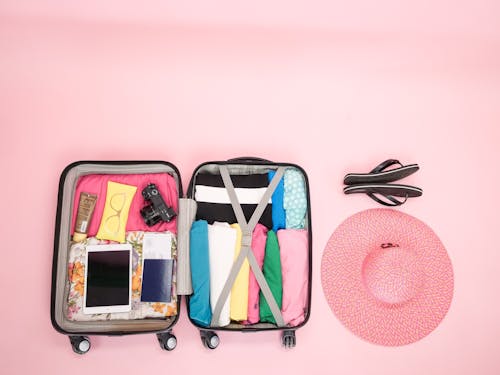 Photo: Max Ocon
Photo: Max Ocon
If you are looking for some quick hack tips for international travel, dip into my article below. It offers general advice on airline restrictions for carry-on luggage and checked-in luggage.
We will explore the importance of choosing the right suitcase for your trip, and the dimensions of the suitcase so that you don’t contravene any airline regulations.
Luggage Options Link
At the end of the article I will include a link to 3 hand-luggage (carry-on suitcase) reviews, and a few links to various airlines which give more details as to what you can and cannot take on board and if there are any additional costs.
A suitcase might seem like a simple travel essential, but choosing the right one can significantly impact your travel experience. A well-suited suitcase should glide through airports and navigate unfamiliar locations at a breeze.
The right size and features, like spinner wheels and a comfortable handle, can prevent unnecessary stress and fatigue.
If it is a sturdy and secure suitcase it safeguards your belongings from rough handling during transportation. Consider hard-shell cases for maximum protection or soft-sided options for flexibility. Also, consider the size of the suitcase. A suitcase that’s too small leads to overpacking and potential damage, while one that’s too big might tempt you to bring unnecessary items, adding weight and bulk.
Meet Strict Size And Weight Airline Restrictions
 If it is overweight, you may incur excess baggage fees if it does not meet with the strict size and weight restrictions for checked-in luggage. Choosing a suitcase that complies with these regulations saves you from excess baggage fees.
If it is overweight, you may incur excess baggage fees if it does not meet with the strict size and weight restrictions for checked-in luggage. Choosing a suitcase that complies with these regulations saves you from excess baggage fees.
Good, Quality Suitcase
I usually think a good quality suitcase is a good investment, as it can last for years. I’ve got one hard-shelled suitcase sitting on top of my wardrobe and it is at least 20 years old. It may be a little scoffed, but it still has a lot of life left in it. Opting for a durable and well-made option reduces the need for frequent replacements.
- This post contains affiliate links that I earn a small commission from at no cost to you.
A good way to check the durability of a suitcase is to look at the handle. The handle should have little to no wiggling or rattling as you pull the bag. Also, check for smooth movement as you pull it up and retract it. The suitcase’s wheels should roll smoothly and stay in place.
My Preference is Hard-shell – But It’s Your Call
Hard-Shell Suitcases:
Pros:
- Superior Protection: Hard shells, typically made from polycarbonate or ABS plastic, offer excellent impact resistance, safeguarding fragile items inside.
- Security: Many hard-shell cases come with TSA-approved locks for added peace of mind.
- Durability: Hard shells can withstand a lot of wear and tear from being tossed around during travel.
- Easy Cleaning: Hard plastic surfaces are generally easier to wipe down and keep clean, especially if you encounter spills or bad weather.
Cons:
- Weight: Hard-shell suitcases tend to be heavier than their soft-shell counterparts, impacting your baggage weight allowance.
- Limited Flexibility: They don’t offer much give, making it harder to squeeze in extra souvenirs or pack oddly shaped items.
- Scratch-Prone: While durable, hard-shell cases can pick up scratches and scuffs, especially with extensive travel.
- Limited Compartments: Some hard-shell designs may have limited internal compartments compared to soft-shell options.

Soft-Shell Suitcases:
Pros:
- Lightweight: Soft-shell suitcases are generally lighter than hard-shell ones, giving you more wiggle room with weight restrictions.
- Expandable: Many soft-shell suitcases have zippers that allow for expansion, providing extra packing space when needed.
- Flexibility: The soft material can conform to odd-shaped items and tight spaces, making them ideal for overpackers or those bringing back souvenirs.
- Compartments: Soft-shell suitcases often have built-in pockets and compartments for better organization.
Cons:
- Protection: Soft-shell materials offer less protection from impacts or crushing compared to hard shells.
- Weatherproofing: While some soft shells are water-resistant, they generally don’t offer the same level of protection against water damage as hard-shell cases.
- Susceptible to Tears: Sharp objects or rough handling can potentially puncture or tear the fabric.
- Less Structured: The lack of a hard shell can make them less stable when packed unevenly.
Ultimately, the best choice depends on your needs:
- Frequent traveler with fragile items? Prioritize hard-shell for protection.
- Value space and weight efficiency? Soft-shell might be your suitcase soulmate.
- Packer extraordinaire who loves a good deal? Soft-shell’s expandability might be a lifesaver.
Some manufacturers offer hard-shell suitcases with expandable compartments, or soft-shell suitcases with reinforced frames for better structure. Consider your travel habits and choose the suitcase that best complements your adventuring style. If you still can’t make up your mind, see my article called The Perfect Suitcase.
Check The Weight and Dimension of Your Suitcase

Stand Suitcase Upright – Measure Length, Width, Height

By following these tips and familiarizing yourself with the specific regulations of your chosen airline, you can ensure your suitcases meet the requirements and you can embark on your journey without any baggage-related hiccups. Features to look for: wheels, compartments, and locks for a hassle-free journey. Check out my three hand luggage carry-on suitcase reviews.
Click on these links to see weight and size restrictions for these airlines: Singapore Airlines Emirates Airlines American Airlines EasyJet


